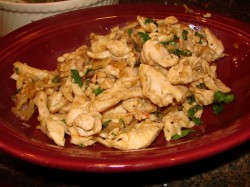What To Do With Nuoc Mau: Stir-Fried Chicken with Lemongrass and Chilies
Now that I have about a cup or so of dark bittersweet delishousness in my fridge, I have to cook with it. While kuo dishes–braised dishes with gooey reddish brown salty-sweet sauce are one of the main uses of nuoc mau in the Vietnamese kitchen, the first recipe I tried was a stir-fry. Like I needed another reason to haul the wok onto the stove, but the combination of flavors promised in this recipe appealed to me: bittersweet caramel, caramelized shallots, browned garlic, fresh Thai bird chilies, lemongrass and fish sauce, all wrapped around tender bits of chicken.
How can that possibly be anything but good?
And, it is very easy to do, very quick to prepare and goes really wonderfully well over steamed jasmine rice, steamed sticky rice or steamed broken rice.
This chicken would be lovely tossed with bean thread noodles or pan-fried rice noodles, too, though one might want to add a bit more liquid to “dress” the noodles if one took that route with this recipe. Of course, if I do try that in the future, I will write about it. Reporting back is always half the fun of trying a new recipe.
I am even pretty sure it would be good as a filling for banh mi, which are those wonderful Vietnamese sandwiches on crusty French baguette that everyone always raves about. (With good reason, mind you–those suckers are tasty.) This summer when the world is bursting with vegetables, I will probably try out lemongrass chicken bahn mi for a quick and light supper, along with some cold noodle salad or maybe a soup.
Stir-Fried Chicken with Lemongrass and Chilies
Ingredients:
2 teaspoons cornstarch
1 tablespoon fish sauce
3/4 pound boneless, skinless chicken breast, sliced into thin 2″X1/2″ pieces
3 tablespoons peanut or canola oil
1 cup thinly sliced fresh shallots
3 cloves garlic, minced
3-10 (to taste) fresh Thai chilies, minced
2 stalks of lemongrass, root ends trimmed, bottom one third of stalks only, tough outer leaves removed, with the rest minced
1/2 cup chicken stock or broth
2 tablespoons fish sauce
1 teaspoon sugar
2 teaspoons nuoc mau
1/2 cup fresh cilantro, roughly chopped
Method:
Mix together cornstarch, first measure of fish sauce and chicken and allow to marinate for twenty minutes.
Heat wok over high heat until a thin thread of smoke wisps up from it. Add oil and heat until it shimmers-between thirty seconds to one minute, depending on how hot your stove is.
Add the shallots and stir and fry until they are golden colored–about two or three minutes. Add the chicken, and spread into a single layer over the bottom of the wok. Sprinkle the garlic, chilies, and lemongrass over the chicken. Allow chicken to sit undisturbed on the bottom of the wok for about a minute to brown slightly. (Chicken is ready when the edges turn white and you can smell the browning meat.) Turn meat and stir fry vigorously, until most of the pink is gone and the chicken is mostly white speckled with golden brown.
Add the chicken stock or broth, fish sauce, sugar and nuoc mau. Deglaze the browned bits on the wok with this mixture, then cook, stirring, until the chicken shows no pink and the sauce is thick and clinging to the meat.
Sprinkle with cilantro, take off heat and stir to combine.
3 Comments
RSS feed for comments on this post.
Sorry, the comment form is closed at this time.
Powered by WordPress. Graphics by Zak Kramer.
Design update by Daniel Trout.
Entries and comments feeds.





Hi Barbara,
I’m not trying to be superpicky, but I guess I am. Banh mi. N before H always. There’s no such word with h before n in VNese. Thanks 🙂
Comment by Wandering Chopsticks — May 4, 2007 #
Aw crap, Wandering. I hate dyslexia (And I do have dyslexia–which sucks for a writer.) Unfortunately, my spell checker doesn’t know from Vietnamese.
I will fix the spelling–thank you for pointing it out to me.
Comment by Barbara — May 4, 2007 #
Not to be too picky, but there is no such language as VNese. I think you mean Vietnamese.
Comment by Michael — February 13, 2008 #